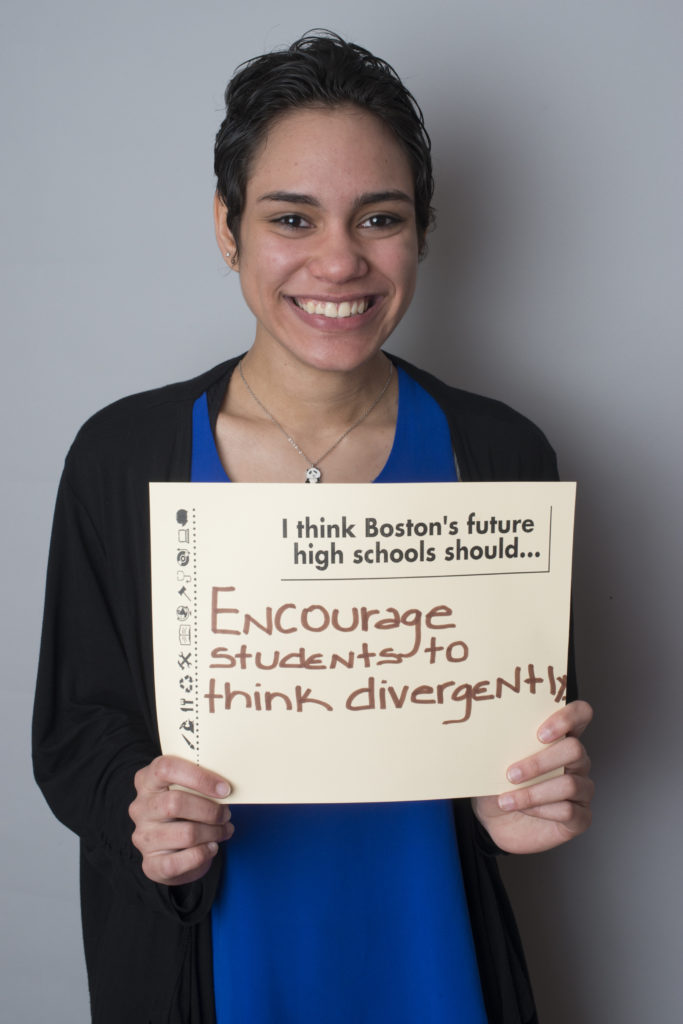
By Priscilla Báez
Convergent thinking is the ability to always give the right answer. The first day of school for students is always about hearing what the teachers says to be correct and incorrect, so they can base their decisions on the classroom standards. The limited ways of learning that are offered for students prevent them from taking the initiative in school projects. In the twenty-first century, students need to learn to be independent thinkers and problem-solvers. The kinds of problems that they will be asked to solve in the ever-growing technological workplace will require that they learn to think outside the box. Divergent thinking is another way to say “thinking outside of the box” to create as many possible solutions to a problem. Through the practice of this type of thinking, people are able to express creativity.
The kinds of problems that they will be asked to solve in the ever-growing technological workplace will require that they learn to think outside the box.
The ability to differentiate when the use of divergent thinking is valid would increase student’s independence in classes, causing less frustration. Stacey Goodman is an artist-teacher focusing on bringing contemporary and social art into the classroom through a balance between divergent thinking and convergent thinking with high school students in grades nine through twelve.. Goodman proposes a strategy to get students to think divergently in classrooms, like instead of asking “questions to which there is a correct answer, try to ask students to formulate their own problem.”[1] A teacher should allow divergent thinking in certain circumstances, so the student doesn’t only learn to follow the instructions.
For instance, Lauren Horn works as a project implementation coordinator at Northeastern University’s Center for STEM education, where she organizes STEM-related programs for K-12 educators, scholars, and community comrades. She also worked as a writer on STEM education for The Boston Globe and Scholastic Inc. Horn describes the free, two-week program held by the Center for STEM Education as an opening for students “to work alongside Northeastern faculty, staff and students on projects aim[ing] at a higher increase in their knowledge of science, technology, engineering and math.”[2]
The acquisition of knowledge in computer programming introduces the students to skills in educational, personal, and professional surroundings. Jean Moon is the founder and principal of a national and international voice in STEM education. Susan Rudell Singer is a college professor of natural sciences. From the experts point of view, they mention how applying STEM “building models, arguing from evidence, and communicating findings increas[es]” the possibilities of the students mastering the concepts of science and math at a “ …more enduring level than otherwise would be the case”[3] The relevancy of knowing computer programming aims at a better possibility for the students to reach a complete mastery of academic material.
Students and teachers may argue that computer programming doesn’t help the student to think divergently. However, this is not fully correct. Emmanuel Schanzer, founder of Bootstrap, which is a software-based curriculum, confirms how a student using Bootstrap “has a higher standardized-testing performance.”[4] This is confirmed by Jordan Shapiro, a psychology educator basing his studies on how video games can be used as a way to solve current global problems. Through the testing of game-based learning system, like Gamestar Mechanics, on a younger audience, he admires how the “game-based learning system… harness[es] the power of computational technologies” and how it also “offers new integrated ways” to understand a “child’s emotional and creative self-expression”[5] From Shapiro’s perspective, computer programming enables others to understand a specific audience mentality and how it also behaves, while relying on the results obtained.
If divergent thinking is practiced in school, there may be poor academic performance in some students. It is important to get high school students prepared for an independent-learning style as they keep learning and experiencing workplaces. In jobs and in college, students should be able to demonstrate leadership by taking initiative in their work and finding the answers independently. Students should know that there are situations where independent work could be the one and only choice, so it is crucial to be prepared for all sorts of occurrences.
- Stacey Goodman, “Fuel Creativity in the Classroom With Divergent Thinking,” Edutopia, March 18, 2014, accessed November 13, 2015, http://www.edutopia.org/blog/fueling-creativity-through-divergent-thinking-classroom-stacey-goodman. ↑
- Lauren Horn, “Bright Young Scientists Present Research,” States News Service, March 14, 2012, accessed November 17, 2015. ↑
- Jean Moon and Susan Rudell Singer, “Bringing STEM Into Focus,” Education Week, January 30, 2012, accessed November 16, 2015, http://www.edweek.org/ew/articles/2012/02/01/19moon.h31.html. ↑
- Emmanuel Schanzer, in discussion with author, January 19, 2016. ↑
- Jordan Shapiro, “How Game-Based Learning Can Save the Humanities,” Forbes, February 18, 2013, accessed November 18, 2015, http://www.forbes.com/sites/jordanshapiro/2013/02/18/how-game-based-learning-can-save-the-humanities/.↑
You must be logged in to post a comment.